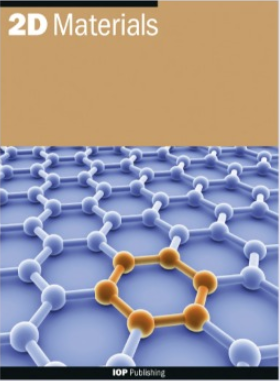Bi2Te3 上外延 Fe3GeTe2 单层的扫描隧道显微镜研究
IF 4.3
3区 材料科学
Q2 MATERIALS SCIENCE, MULTIDISCIPLINARY
引用次数: 0
摘要
在 Bi2Te3 等拓扑绝缘体的表面状态中引入磁性会导致各种有趣的现象。我们利用扫描隧道显微镜(STM)研究了通过分子束外延生长在 Bi2Te3 上的范德华磁铁 Fe3GeTe2(FGT)的单个五重层(QL)。STM 拓扑图像显示,FGT 在 Bi2Te3 上以独立岛屿的形式生长,并从 Bi2Te3 台阶向外生长。原子分辨率成像显示,FGT 的三角晶格为 390 ± 10 pm,Bi2Te3 的三角晶格为 430 ± 10 pm,与各自的块状晶体一致。在 FGT 区域观察到周期为 4.3 ± 0.4 nm 的摩尔纹,这完全是由于晶格不匹配造成的,因此表明旋转错位为零。虽然大部分表面都被 FGT 的单个 QL 所覆盖,但也有一些小的双 QL 区域,以及由于不完整的 QL 而产生明显化学终止的区域。最常见的部分 QL 表面终止是铁锗层,其中顶部的两个原子层缺失。这种终止具有独特的电子结构,并在 STM 图像的摩尔纹上叠加了 3 x 3R30∘ 重构。磁圆二色性测量证实这些 FGT 薄膜具有铁磁性,TC ∼190 K。本文章由计算机程序翻译,如有差异,请以英文原文为准。
Scanning tunneling microscopy study of epitaxial Fe3GeTe2 monolayers on Bi2Te3
Introducing magnetism to the surface state of topological insulators, such as Bi2Te3, can lead to a variety of interesting phenomena. We use scanning tunneling microscopy (STM) to study a single quintuple layer (QL) of the van der Waals magnet Fe3GeTe2 (FGT) that is grown on Bi2Te3 via molecular beam epitaxy. STM topographic images show that the FGT grows as free-standing islands on Bi2Te3 and outwards from Bi2Te3 steps. Atomic resolution imaging shows triangular lattices of 390 ± 10 pm for FGT and 430 ± 10 pm for Bi2Te3, consistent with the respective bulk crystals. A moiré pattern is observed on FGT regions with a periodicity of 4.3 ± 0.4 nm that can be attributed solely to this lattice mismatch and thus indicates zero rotational misalignment. While most of the surface is covered by a single QL of the FGT, there are small double QL regions, as well as regions with distinct chemical terminations due to an incomplete QL. The most common partial QL surface termination is the FeGe layer, in which the top two atomic layers are missing. This termination has a distinctive electronic structure and a
3 x 3 R 30 ∘ reconstruction overlaid on the moiré pattern in STM images. Magnetic circular dichroism measurements confirm these thin FGT films are ferromagnetic with T
C ∼190 K.
求助全文
通过发布文献求助,成功后即可免费获取论文全文。
去求助
来源期刊

2D Materials
MATERIALS SCIENCE, MULTIDISCIPLINARY-
CiteScore
10.70
自引率
5.50%
发文量
138
审稿时长
1.5 months
期刊介绍:
2D Materials is a multidisciplinary, electronic-only journal devoted to publishing fundamental and applied research of the highest quality and impact covering all aspects of graphene and related two-dimensional materials.
 求助内容:
求助内容: 应助结果提醒方式:
应助结果提醒方式:


